BMP3005 - Applied Business Finance: Financial Analysis Report
VerifiedAdded on 2023/06/15
|11
|2733
|160
Report
AI Summary
This report provides a comprehensive overview of financial management concepts and their importance in business. It delves into the main financial statements, including the balance sheet and income statement, and explains the use of financial ratios for evaluating a company's profitability, liquidity, and efficiency. The report includes a practical application of these concepts, utilizing a business review template and Excel to generate financial statements and conduct ratio analysis based on a provided case study. It further discusses how businesses can improve their financial performance through strategic financial management processes. The document emphasizes the role of financial analysis in informed decision-making and long-term business sustainability. Desklib provides access to similar solved assignments and study resources for students.
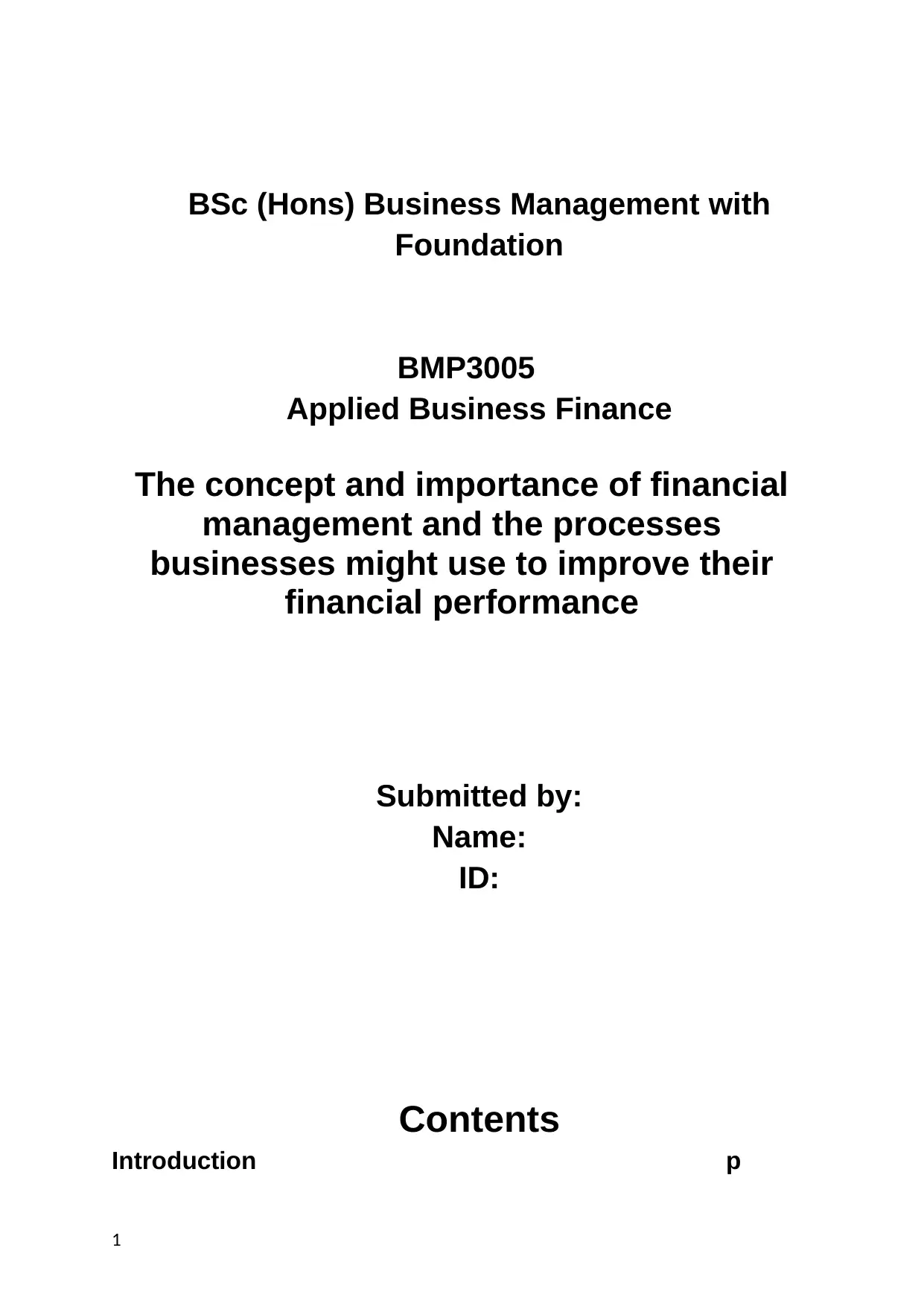
BSc (Hons) Business Management with
Foundation
BMP3005
Applied Business Finance
The concept and importance of financial
management and the processes
businesses might use to improve their
financial performance
Submitted by:
Name:
ID:
Contents
Introduction p
1
Foundation
BMP3005
Applied Business Finance
The concept and importance of financial
management and the processes
businesses might use to improve their
financial performance
Submitted by:
Name:
ID:
Contents
Introduction p
1
Paraphrase This Document
Need a fresh take? Get an instant paraphrase of this document with our AI Paraphraser
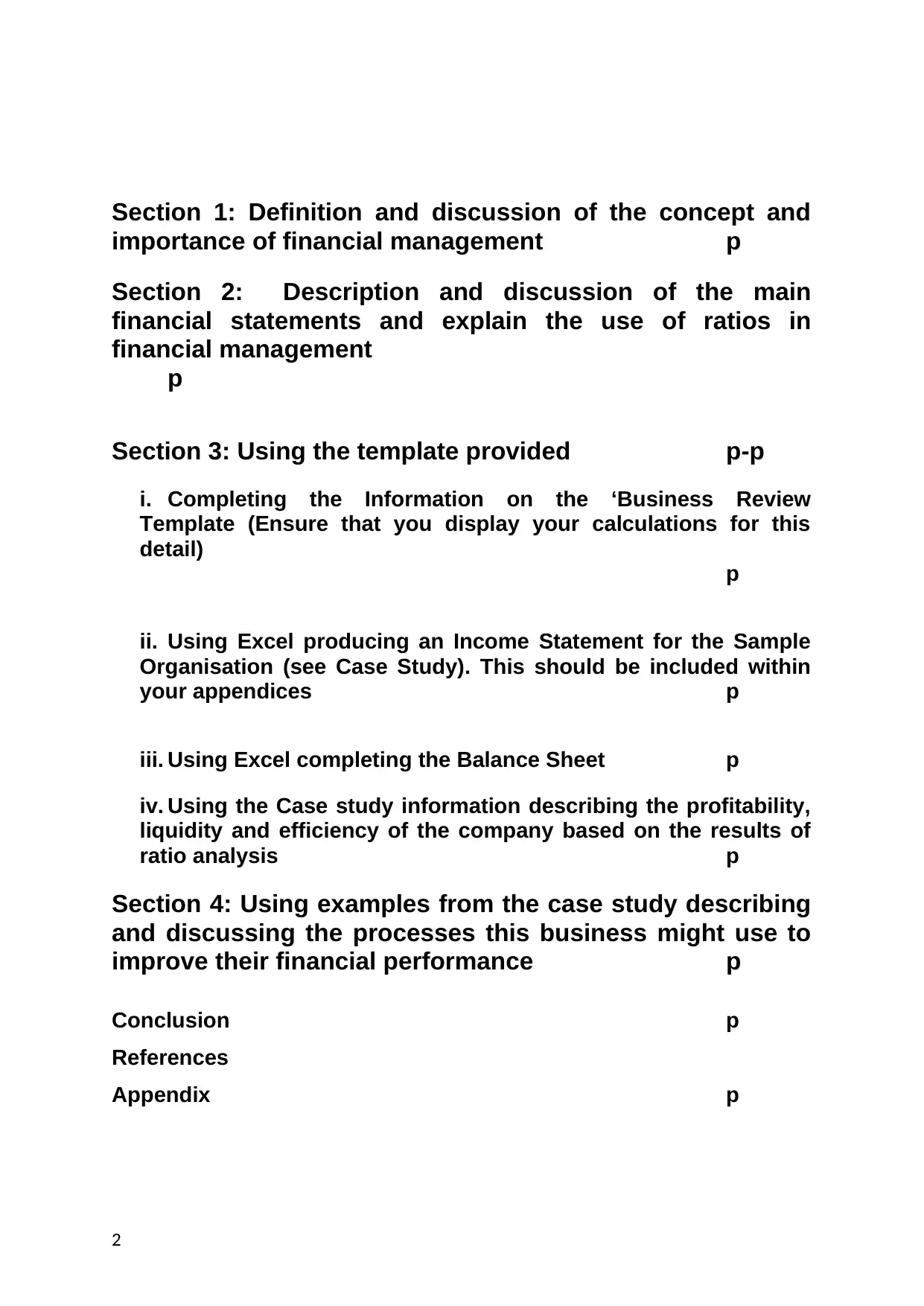
Section 1: Definition and discussion of the concept and
importance of financial management p
Section 2: Description and discussion of the main
financial statements and explain the use of ratios in
financial management
p
Section 3: Using the template provided p-p
i. Completing the Information on the ‘Business Review
Template (Ensure that you display your calculations for this
detail)
p
ii. Using Excel producing an Income Statement for the Sample
Organisation (see Case Study). This should be included within
your appendices p
iii. Using Excel completing the Balance Sheet p
iv. Using the Case study information describing the profitability,
liquidity and efficiency of the company based on the results of
ratio analysis p
Section 4: Using examples from the case study describing
and discussing the processes this business might use to
improve their financial performance p
Conclusion p
References
Appendix p
2
importance of financial management p
Section 2: Description and discussion of the main
financial statements and explain the use of ratios in
financial management
p
Section 3: Using the template provided p-p
i. Completing the Information on the ‘Business Review
Template (Ensure that you display your calculations for this
detail)
p
ii. Using Excel producing an Income Statement for the Sample
Organisation (see Case Study). This should be included within
your appendices p
iii. Using Excel completing the Balance Sheet p
iv. Using the Case study information describing the profitability,
liquidity and efficiency of the company based on the results of
ratio analysis p
Section 4: Using examples from the case study describing
and discussing the processes this business might use to
improve their financial performance p
Conclusion p
References
Appendix p
2

3
⊘ This is a preview!⊘
Do you want full access?
Subscribe today to unlock all pages.

Trusted by 1+ million students worldwide
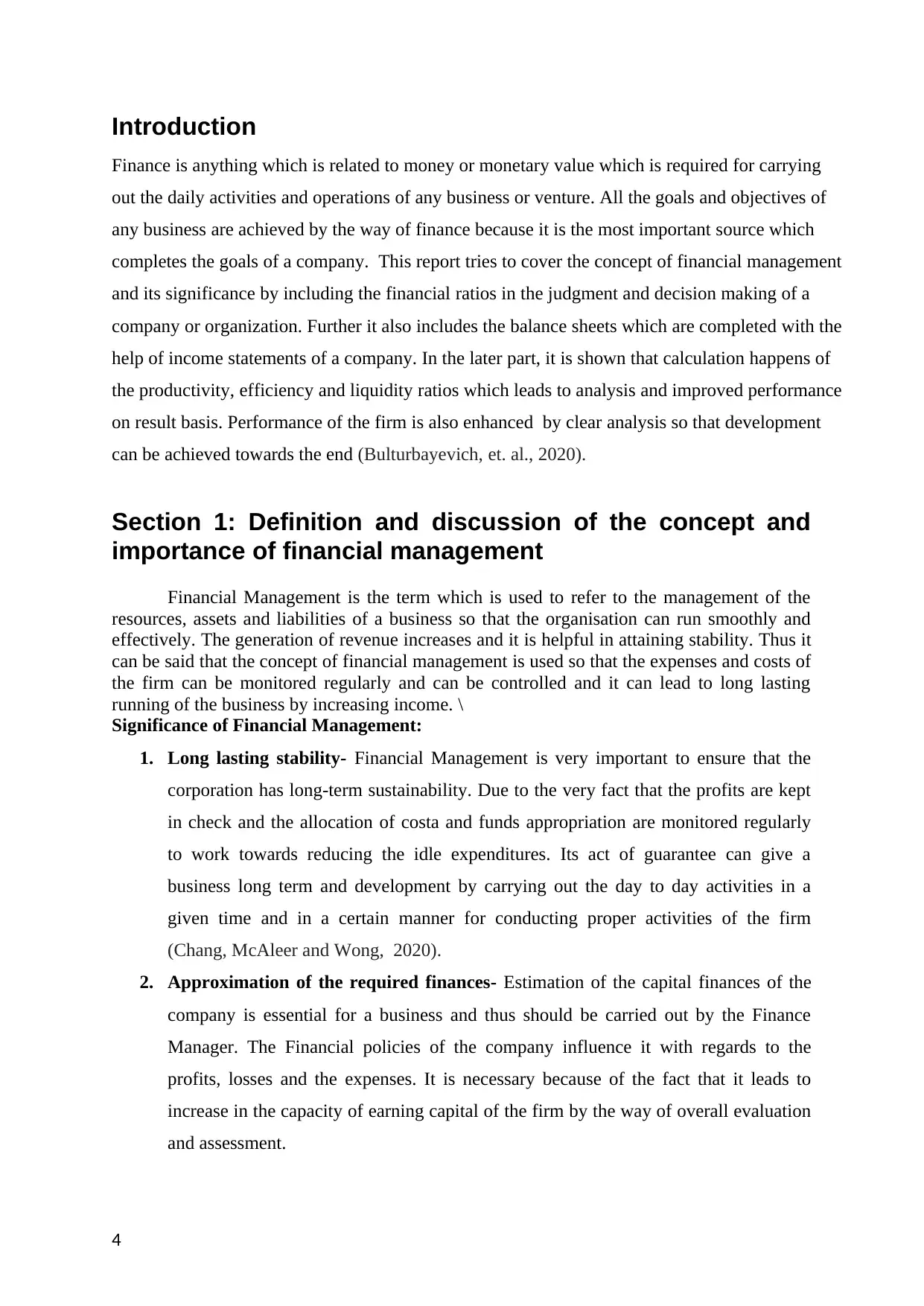
Introduction
Finance is anything which is related to money or monetary value which is required for carrying
out the daily activities and operations of any business or venture. All the goals and objectives of
any business are achieved by the way of finance because it is the most important source which
completes the goals of a company. This report tries to cover the concept of financial management
and its significance by including the financial ratios in the judgment and decision making of a
company or organization. Further it also includes the balance sheets which are completed with the
help of income statements of a company. In the later part, it is shown that calculation happens of
the productivity, efficiency and liquidity ratios which leads to analysis and improved performance
on result basis. Performance of the firm is also enhanced by clear analysis so that development
can be achieved towards the end (Bulturbayevich, et. al., 2020).
Section 1: Definition and discussion of the concept and
importance of financial management
Financial Management is the term which is used to refer to the management of the
resources, assets and liabilities of a business so that the organisation can run smoothly and
effectively. The generation of revenue increases and it is helpful in attaining stability. Thus it
can be said that the concept of financial management is used so that the expenses and costs of
the firm can be monitored regularly and can be controlled and it can lead to long lasting
running of the business by increasing income. \
Significance of Financial Management:
1. Long lasting stability- Financial Management is very important to ensure that the
corporation has long-term sustainability. Due to the very fact that the profits are kept
in check and the allocation of costa and funds appropriation are monitored regularly
to work towards reducing the idle expenditures. Its act of guarantee can give a
business long term and development by carrying out the day to day activities in a
given time and in a certain manner for conducting proper activities of the firm
(Chang, McAleer and Wong, 2020).
2. Approximation of the required finances- Estimation of the capital finances of the
company is essential for a business and thus should be carried out by the Finance
Manager. The Financial policies of the company influence it with regards to the
profits, losses and the expenses. It is necessary because of the fact that it leads to
increase in the capacity of earning capital of the firm by the way of overall evaluation
and assessment.
4
Finance is anything which is related to money or monetary value which is required for carrying
out the daily activities and operations of any business or venture. All the goals and objectives of
any business are achieved by the way of finance because it is the most important source which
completes the goals of a company. This report tries to cover the concept of financial management
and its significance by including the financial ratios in the judgment and decision making of a
company or organization. Further it also includes the balance sheets which are completed with the
help of income statements of a company. In the later part, it is shown that calculation happens of
the productivity, efficiency and liquidity ratios which leads to analysis and improved performance
on result basis. Performance of the firm is also enhanced by clear analysis so that development
can be achieved towards the end (Bulturbayevich, et. al., 2020).
Section 1: Definition and discussion of the concept and
importance of financial management
Financial Management is the term which is used to refer to the management of the
resources, assets and liabilities of a business so that the organisation can run smoothly and
effectively. The generation of revenue increases and it is helpful in attaining stability. Thus it
can be said that the concept of financial management is used so that the expenses and costs of
the firm can be monitored regularly and can be controlled and it can lead to long lasting
running of the business by increasing income. \
Significance of Financial Management:
1. Long lasting stability- Financial Management is very important to ensure that the
corporation has long-term sustainability. Due to the very fact that the profits are kept
in check and the allocation of costa and funds appropriation are monitored regularly
to work towards reducing the idle expenditures. Its act of guarantee can give a
business long term and development by carrying out the day to day activities in a
given time and in a certain manner for conducting proper activities of the firm
(Chang, McAleer and Wong, 2020).
2. Approximation of the required finances- Estimation of the capital finances of the
company is essential for a business and thus should be carried out by the Finance
Manager. The Financial policies of the company influence it with regards to the
profits, losses and the expenses. It is necessary because of the fact that it leads to
increase in the capacity of earning capital of the firm by the way of overall evaluation
and assessment.
4
Paraphrase This Document
Need a fresh take? Get an instant paraphrase of this document with our AI Paraphraser
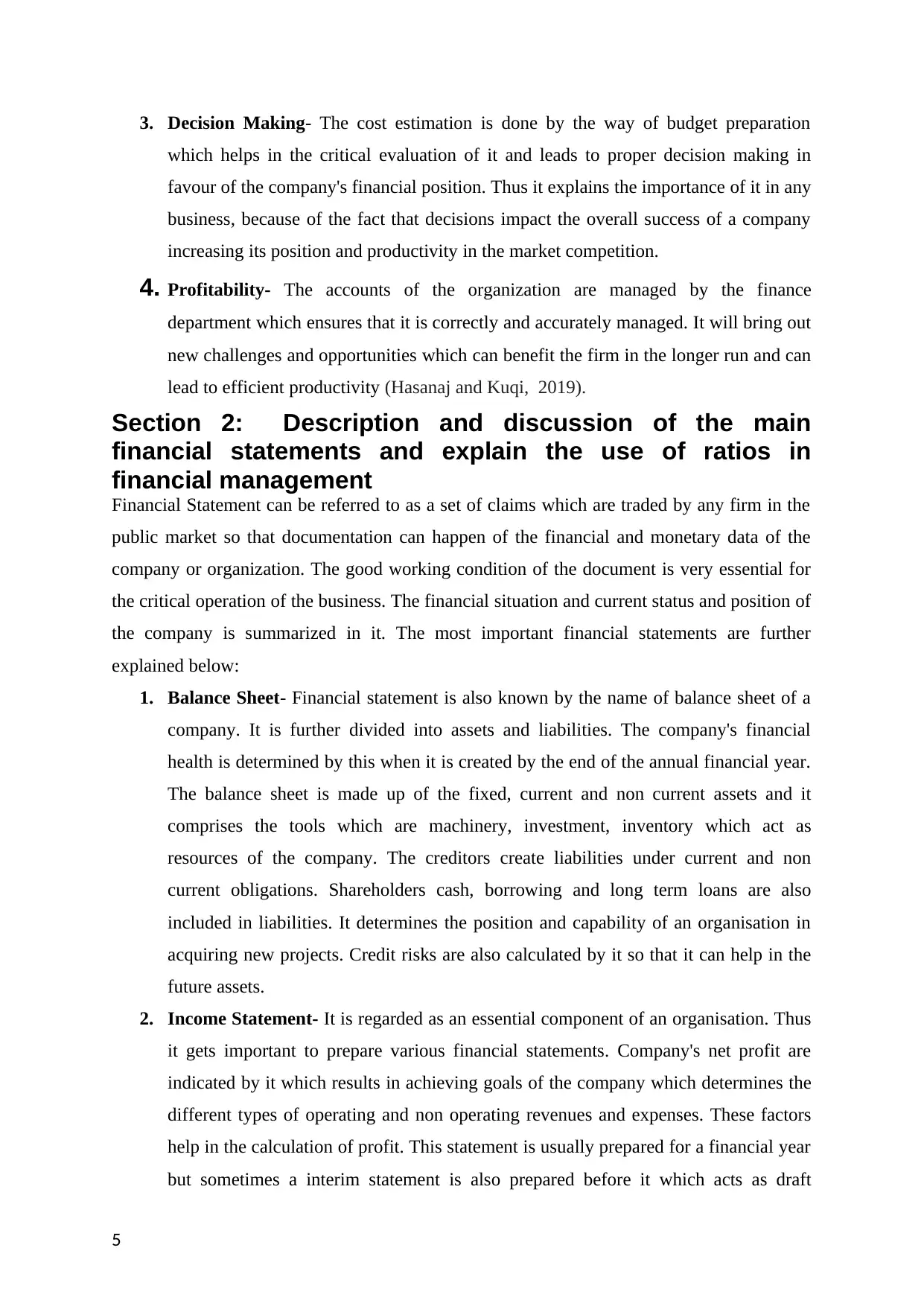
3. Decision Making- The cost estimation is done by the way of budget preparation
which helps in the critical evaluation of it and leads to proper decision making in
favour of the company's financial position. Thus it explains the importance of it in any
business, because of the fact that decisions impact the overall success of a company
increasing its position and productivity in the market competition.
4. Profitability- The accounts of the organization are managed by the finance
department which ensures that it is correctly and accurately managed. It will bring out
new challenges and opportunities which can benefit the firm in the longer run and can
lead to efficient productivity (Hasanaj and Kuqi, 2019).
Section 2: Description and discussion of the main
financial statements and explain the use of ratios in
financial management
Financial Statement can be referred to as a set of claims which are traded by any firm in the
public market so that documentation can happen of the financial and monetary data of the
company or organization. The good working condition of the document is very essential for
the critical operation of the business. The financial situation and current status and position of
the company is summarized in it. The most important financial statements are further
explained below:
1. Balance Sheet- Financial statement is also known by the name of balance sheet of a
company. It is further divided into assets and liabilities. The company's financial
health is determined by this when it is created by the end of the annual financial year.
The balance sheet is made up of the fixed, current and non current assets and it
comprises the tools which are machinery, investment, inventory which act as
resources of the company. The creditors create liabilities under current and non
current obligations. Shareholders cash, borrowing and long term loans are also
included in liabilities. It determines the position and capability of an organisation in
acquiring new projects. Credit risks are also calculated by it so that it can help in the
future assets.
2. Income Statement- It is regarded as an essential component of an organisation. Thus
it gets important to prepare various financial statements. Company's net profit are
indicated by it which results in achieving goals of the company which determines the
different types of operating and non operating revenues and expenses. These factors
help in the calculation of profit. This statement is usually prepared for a financial year
but sometimes a interim statement is also prepared before it which acts as draft
5
which helps in the critical evaluation of it and leads to proper decision making in
favour of the company's financial position. Thus it explains the importance of it in any
business, because of the fact that decisions impact the overall success of a company
increasing its position and productivity in the market competition.
4. Profitability- The accounts of the organization are managed by the finance
department which ensures that it is correctly and accurately managed. It will bring out
new challenges and opportunities which can benefit the firm in the longer run and can
lead to efficient productivity (Hasanaj and Kuqi, 2019).
Section 2: Description and discussion of the main
financial statements and explain the use of ratios in
financial management
Financial Statement can be referred to as a set of claims which are traded by any firm in the
public market so that documentation can happen of the financial and monetary data of the
company or organization. The good working condition of the document is very essential for
the critical operation of the business. The financial situation and current status and position of
the company is summarized in it. The most important financial statements are further
explained below:
1. Balance Sheet- Financial statement is also known by the name of balance sheet of a
company. It is further divided into assets and liabilities. The company's financial
health is determined by this when it is created by the end of the annual financial year.
The balance sheet is made up of the fixed, current and non current assets and it
comprises the tools which are machinery, investment, inventory which act as
resources of the company. The creditors create liabilities under current and non
current obligations. Shareholders cash, borrowing and long term loans are also
included in liabilities. It determines the position and capability of an organisation in
acquiring new projects. Credit risks are also calculated by it so that it can help in the
future assets.
2. Income Statement- It is regarded as an essential component of an organisation. Thus
it gets important to prepare various financial statements. Company's net profit are
indicated by it which results in achieving goals of the company which determines the
different types of operating and non operating revenues and expenses. These factors
help in the calculation of profit. This statement is usually prepared for a financial year
but sometimes a interim statement is also prepared before it which acts as draft
5
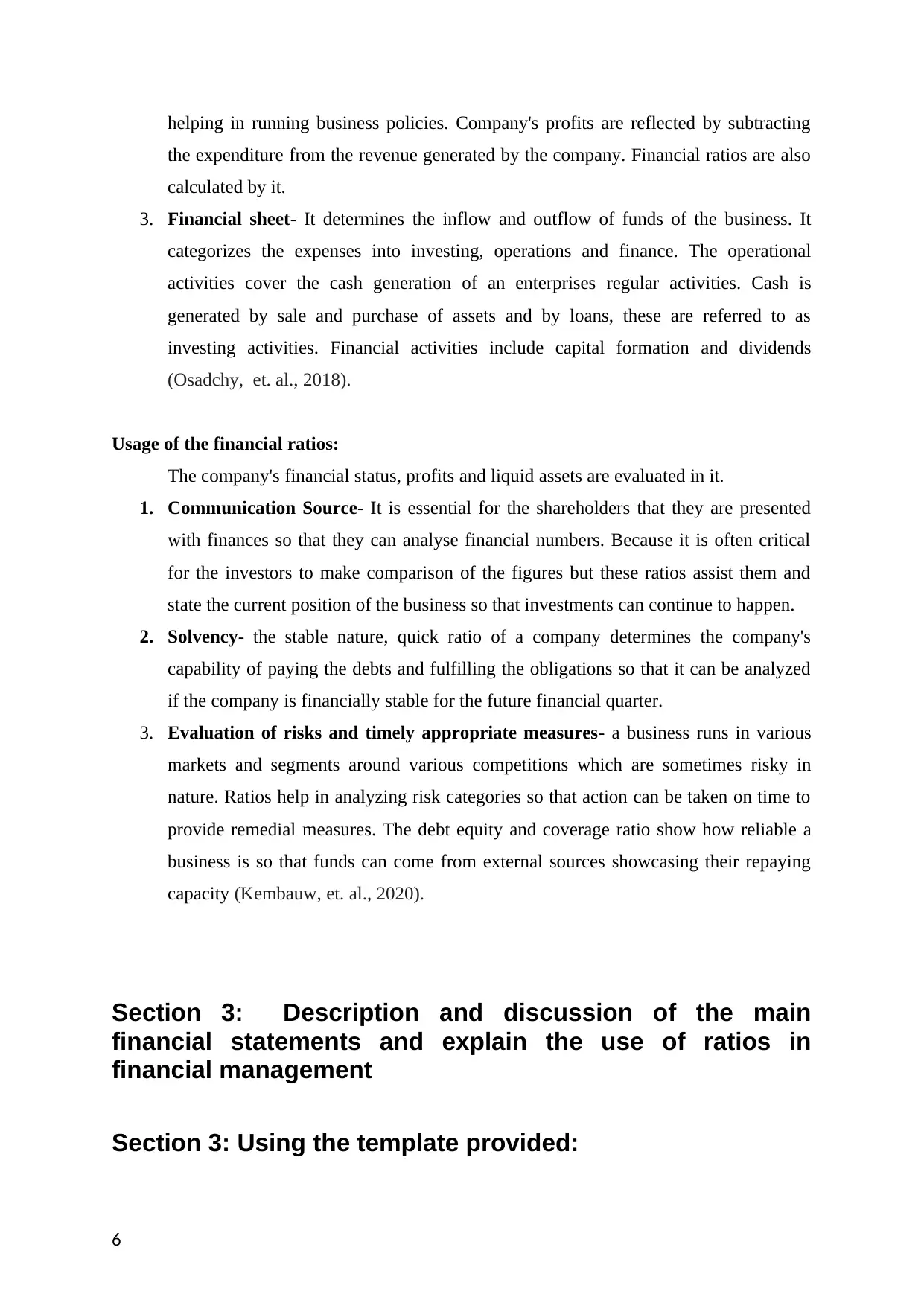
helping in running business policies. Company's profits are reflected by subtracting
the expenditure from the revenue generated by the company. Financial ratios are also
calculated by it.
3. Financial sheet- It determines the inflow and outflow of funds of the business. It
categorizes the expenses into investing, operations and finance. The operational
activities cover the cash generation of an enterprises regular activities. Cash is
generated by sale and purchase of assets and by loans, these are referred to as
investing activities. Financial activities include capital formation and dividends
(Osadchy, et. al., 2018).
Usage of the financial ratios:
The company's financial status, profits and liquid assets are evaluated in it.
1. Communication Source- It is essential for the shareholders that they are presented
with finances so that they can analyse financial numbers. Because it is often critical
for the investors to make comparison of the figures but these ratios assist them and
state the current position of the business so that investments can continue to happen.
2. Solvency- the stable nature, quick ratio of a company determines the company's
capability of paying the debts and fulfilling the obligations so that it can be analyzed
if the company is financially stable for the future financial quarter.
3. Evaluation of risks and timely appropriate measures- a business runs in various
markets and segments around various competitions which are sometimes risky in
nature. Ratios help in analyzing risk categories so that action can be taken on time to
provide remedial measures. The debt equity and coverage ratio show how reliable a
business is so that funds can come from external sources showcasing their repaying
capacity (Kembauw, et. al., 2020).
Section 3: Description and discussion of the main
financial statements and explain the use of ratios in
financial management
Section 3: Using the template provided:
6
the expenditure from the revenue generated by the company. Financial ratios are also
calculated by it.
3. Financial sheet- It determines the inflow and outflow of funds of the business. It
categorizes the expenses into investing, operations and finance. The operational
activities cover the cash generation of an enterprises regular activities. Cash is
generated by sale and purchase of assets and by loans, these are referred to as
investing activities. Financial activities include capital formation and dividends
(Osadchy, et. al., 2018).
Usage of the financial ratios:
The company's financial status, profits and liquid assets are evaluated in it.
1. Communication Source- It is essential for the shareholders that they are presented
with finances so that they can analyse financial numbers. Because it is often critical
for the investors to make comparison of the figures but these ratios assist them and
state the current position of the business so that investments can continue to happen.
2. Solvency- the stable nature, quick ratio of a company determines the company's
capability of paying the debts and fulfilling the obligations so that it can be analyzed
if the company is financially stable for the future financial quarter.
3. Evaluation of risks and timely appropriate measures- a business runs in various
markets and segments around various competitions which are sometimes risky in
nature. Ratios help in analyzing risk categories so that action can be taken on time to
provide remedial measures. The debt equity and coverage ratio show how reliable a
business is so that funds can come from external sources showcasing their repaying
capacity (Kembauw, et. al., 2020).
Section 3: Description and discussion of the main
financial statements and explain the use of ratios in
financial management
Section 3: Using the template provided:
6
⊘ This is a preview!⊘
Do you want full access?
Subscribe today to unlock all pages.

Trusted by 1+ million students worldwide
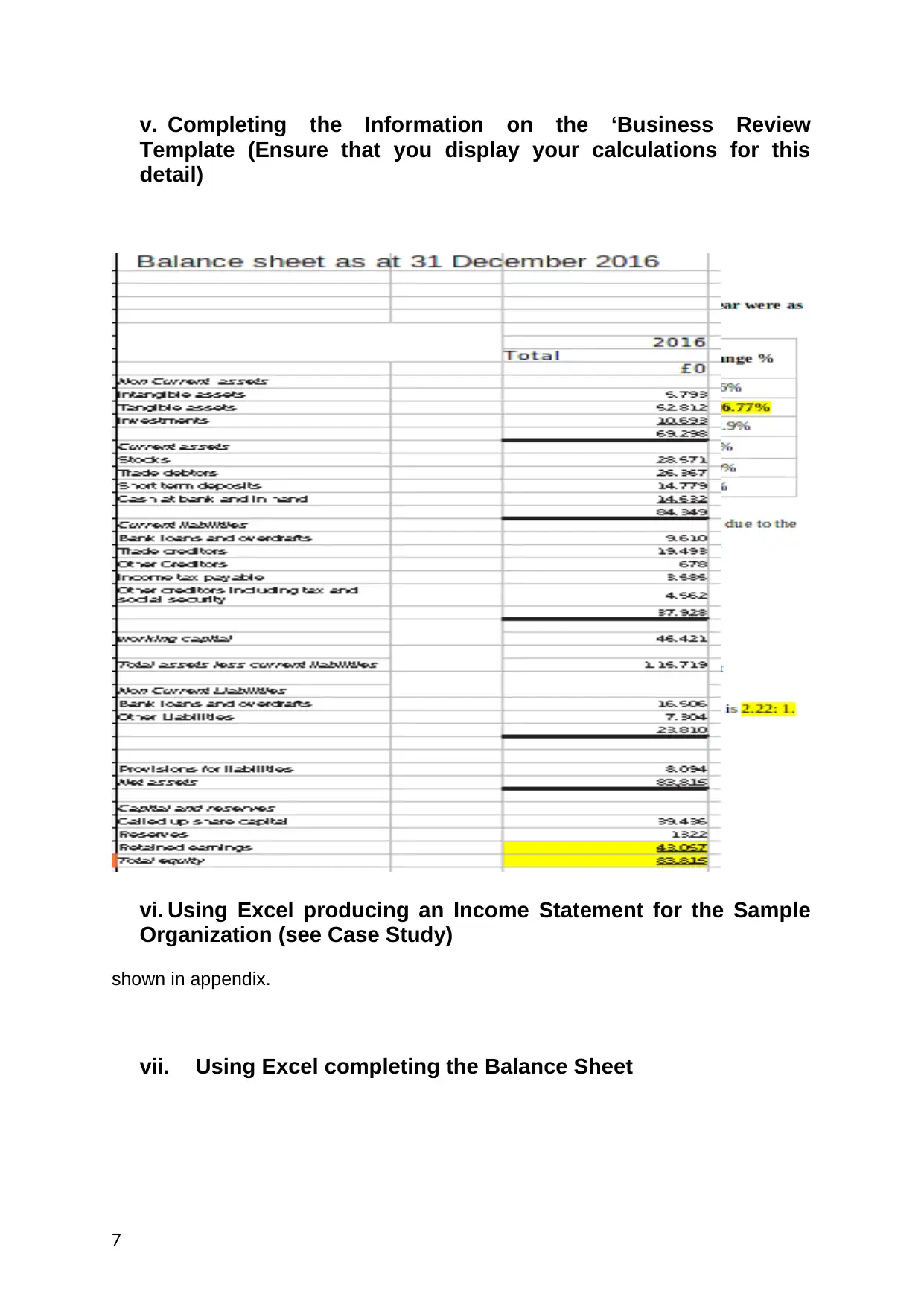
v. Completing the Information on the ‘Business Review
Template (Ensure that you display your calculations for this
detail)
vi. Using Excel producing an Income Statement for the Sample
Organization (see Case Study)
shown in appendix.
vii. Using Excel completing the Balance Sheet
7
Template (Ensure that you display your calculations for this
detail)
vi. Using Excel producing an Income Statement for the Sample
Organization (see Case Study)
shown in appendix.
vii. Using Excel completing the Balance Sheet
7
Paraphrase This Document
Need a fresh take? Get an instant paraphrase of this document with our AI Paraphraser
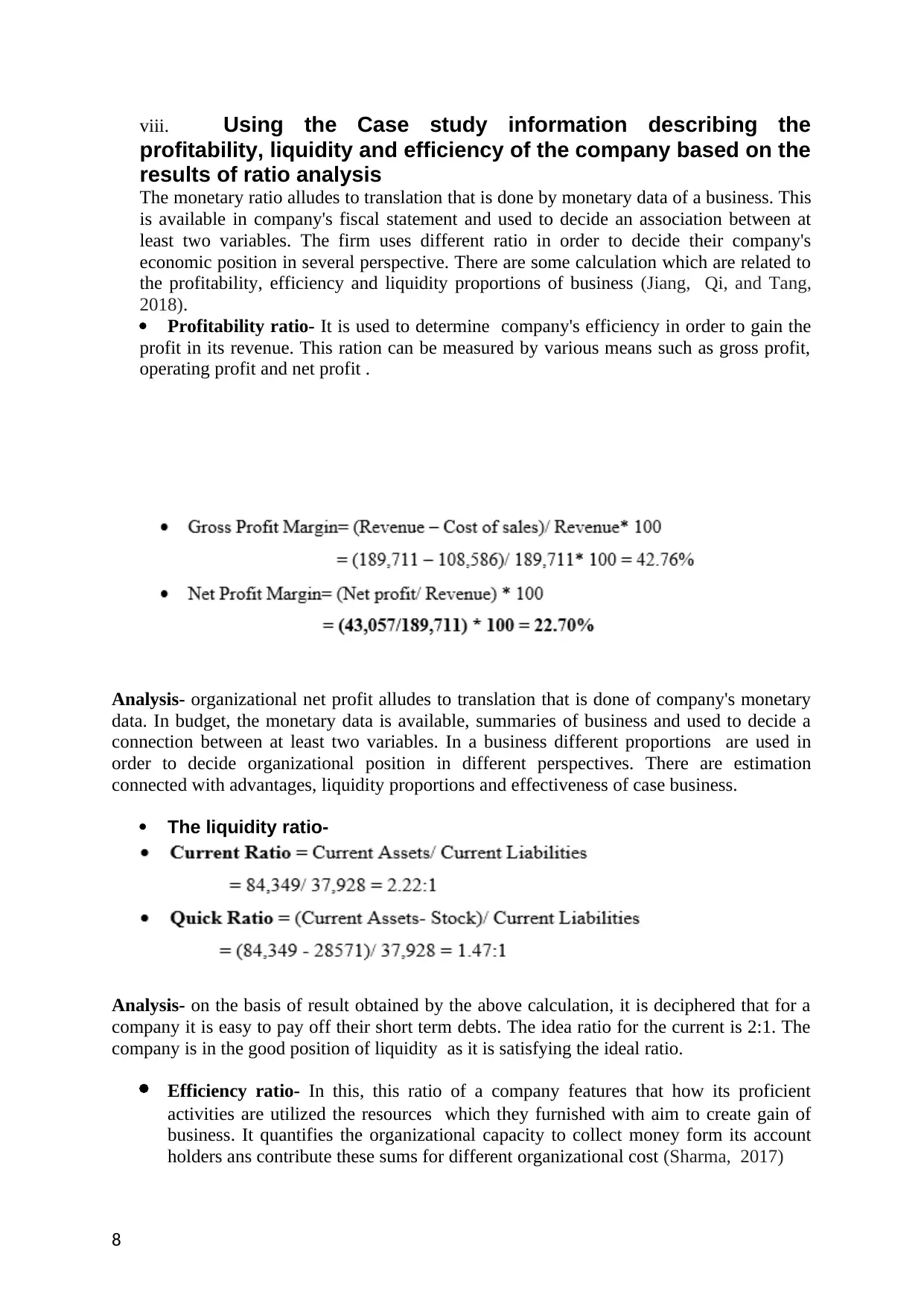
viii. Using the Case study information describing the
profitability, liquidity and efficiency of the company based on the
results of ratio analysis
The monetary ratio alludes to translation that is done by monetary data of a business. This
is available in company's fiscal statement and used to decide an association between at
least two variables. The firm uses different ratio in order to decide their company's
economic position in several perspective. There are some calculation which are related to
the profitability, efficiency and liquidity proportions of business (Jiang, Qi, and Tang,
2018).
Profitability ratio- It is used to determine company's efficiency in order to gain the
profit in its revenue. This ration can be measured by various means such as gross profit,
operating profit and net profit .
Analysis- organizational net profit alludes to translation that is done of company's monetary
data. In budget, the monetary data is available, summaries of business and used to decide a
connection between at least two variables. In a business different proportions are used in
order to decide organizational position in different perspectives. There are estimation
connected with advantages, liquidity proportions and effectiveness of case business.
The liquidity ratio-
Analysis- on the basis of result obtained by the above calculation, it is deciphered that for a
company it is easy to pay off their short term debts. The idea ratio for the current is 2:1. The
company is in the good position of liquidity as it is satisfying the ideal ratio.
Efficiency ratio- In this, this ratio of a company features that how its proficient
activities are utilized the resources which they furnished with aim to create gain of
business. It quantifies the organizational capacity to collect money form its account
holders ans contribute these sums for different organizational cost (Sharma, 2017)
8
profitability, liquidity and efficiency of the company based on the
results of ratio analysis
The monetary ratio alludes to translation that is done by monetary data of a business. This
is available in company's fiscal statement and used to decide an association between at
least two variables. The firm uses different ratio in order to decide their company's
economic position in several perspective. There are some calculation which are related to
the profitability, efficiency and liquidity proportions of business (Jiang, Qi, and Tang,
2018).
Profitability ratio- It is used to determine company's efficiency in order to gain the
profit in its revenue. This ration can be measured by various means such as gross profit,
operating profit and net profit .
Analysis- organizational net profit alludes to translation that is done of company's monetary
data. In budget, the monetary data is available, summaries of business and used to decide a
connection between at least two variables. In a business different proportions are used in
order to decide organizational position in different perspectives. There are estimation
connected with advantages, liquidity proportions and effectiveness of case business.
The liquidity ratio-
Analysis- on the basis of result obtained by the above calculation, it is deciphered that for a
company it is easy to pay off their short term debts. The idea ratio for the current is 2:1. The
company is in the good position of liquidity as it is satisfying the ideal ratio.
Efficiency ratio- In this, this ratio of a company features that how its proficient
activities are utilized the resources which they furnished with aim to create gain of
business. It quantifies the organizational capacity to collect money form its account
holders ans contribute these sums for different organizational cost (Sharma, 2017)
8
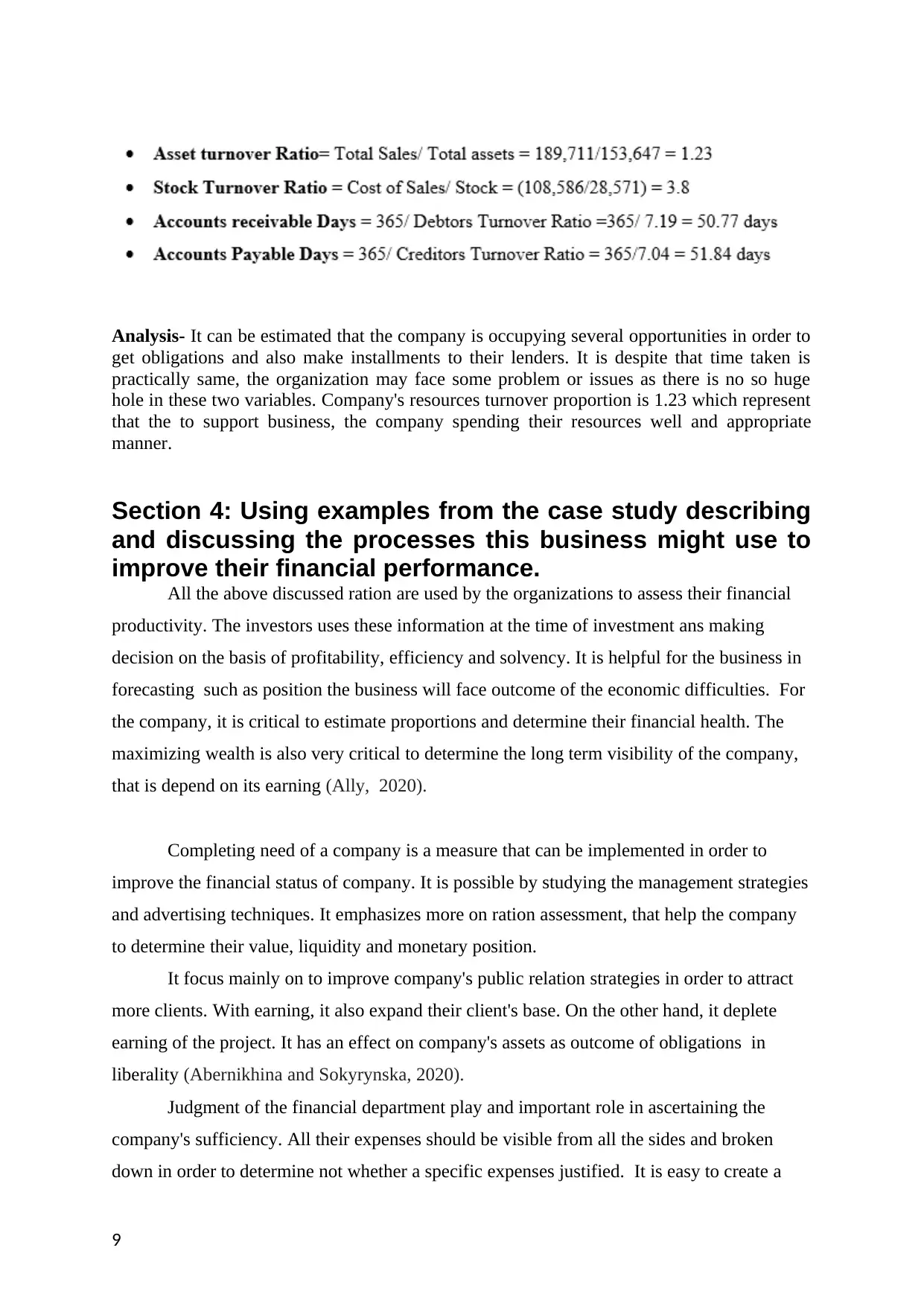
Analysis- It can be estimated that the company is occupying several opportunities in order to
get obligations and also make installments to their lenders. It is despite that time taken is
practically same, the organization may face some problem or issues as there is no so huge
hole in these two variables. Company's resources turnover proportion is 1.23 which represent
that the to support business, the company spending their resources well and appropriate
manner.
Section 4: Using examples from the case study describing
and discussing the processes this business might use to
improve their financial performance.
All the above discussed ration are used by the organizations to assess their financial
productivity. The investors uses these information at the time of investment ans making
decision on the basis of profitability, efficiency and solvency. It is helpful for the business in
forecasting such as position the business will face outcome of the economic difficulties. For
the company, it is critical to estimate proportions and determine their financial health. The
maximizing wealth is also very critical to determine the long term visibility of the company,
that is depend on its earning (Ally, 2020).
Completing need of a company is a measure that can be implemented in order to
improve the financial status of company. It is possible by studying the management strategies
and advertising techniques. It emphasizes more on ration assessment, that help the company
to determine their value, liquidity and monetary position.
It focus mainly on to improve company's public relation strategies in order to attract
more clients. With earning, it also expand their client's base. On the other hand, it deplete
earning of the project. It has an effect on company's assets as outcome of obligations in
liberality (Abernikhina and Sokyrynska, 2020).
Judgment of the financial department play and important role in ascertaining the
company's sufficiency. All their expenses should be visible from all the sides and broken
down in order to determine not whether a specific expenses justified. It is easy to create a
9
get obligations and also make installments to their lenders. It is despite that time taken is
practically same, the organization may face some problem or issues as there is no so huge
hole in these two variables. Company's resources turnover proportion is 1.23 which represent
that the to support business, the company spending their resources well and appropriate
manner.
Section 4: Using examples from the case study describing
and discussing the processes this business might use to
improve their financial performance.
All the above discussed ration are used by the organizations to assess their financial
productivity. The investors uses these information at the time of investment ans making
decision on the basis of profitability, efficiency and solvency. It is helpful for the business in
forecasting such as position the business will face outcome of the economic difficulties. For
the company, it is critical to estimate proportions and determine their financial health. The
maximizing wealth is also very critical to determine the long term visibility of the company,
that is depend on its earning (Ally, 2020).
Completing need of a company is a measure that can be implemented in order to
improve the financial status of company. It is possible by studying the management strategies
and advertising techniques. It emphasizes more on ration assessment, that help the company
to determine their value, liquidity and monetary position.
It focus mainly on to improve company's public relation strategies in order to attract
more clients. With earning, it also expand their client's base. On the other hand, it deplete
earning of the project. It has an effect on company's assets as outcome of obligations in
liberality (Abernikhina and Sokyrynska, 2020).
Judgment of the financial department play and important role in ascertaining the
company's sufficiency. All their expenses should be visible from all the sides and broken
down in order to determine not whether a specific expenses justified. It is easy to create a
9
⊘ This is a preview!⊘
Do you want full access?
Subscribe today to unlock all pages.

Trusted by 1+ million students worldwide
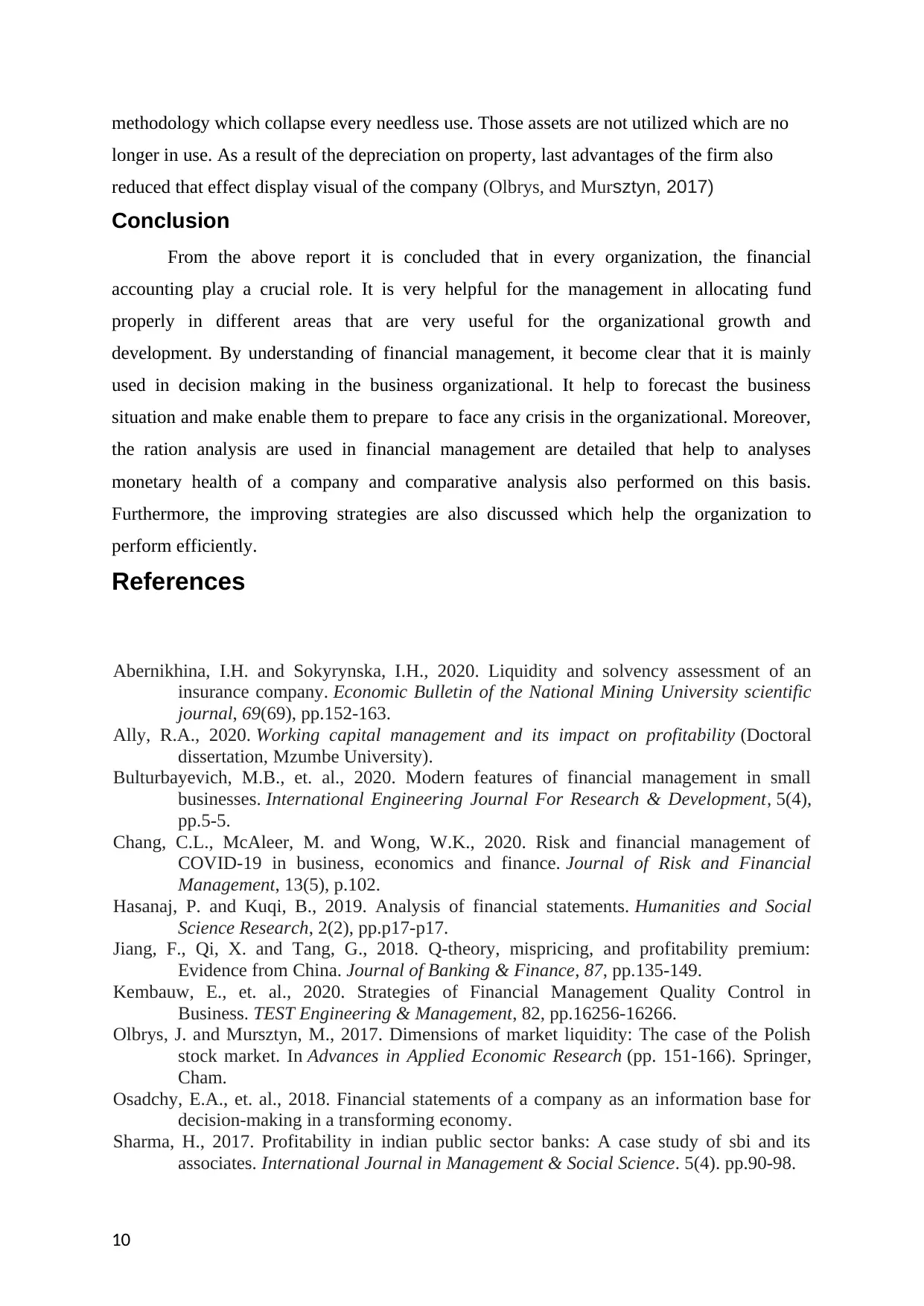
methodology which collapse every needless use. Those assets are not utilized which are no
longer in use. As a result of the depreciation on property, last advantages of the firm also
reduced that effect display visual of the company (Olbrys, and Mursztyn, 2017)
Conclusion
From the above report it is concluded that in every organization, the financial
accounting play a crucial role. It is very helpful for the management in allocating fund
properly in different areas that are very useful for the organizational growth and
development. By understanding of financial management, it become clear that it is mainly
used in decision making in the business organizational. It help to forecast the business
situation and make enable them to prepare to face any crisis in the organizational. Moreover,
the ration analysis are used in financial management are detailed that help to analyses
monetary health of a company and comparative analysis also performed on this basis.
Furthermore, the improving strategies are also discussed which help the organization to
perform efficiently.
References
Abernikhina, I.H. and Sokyrynska, I.H., 2020. Liquidity and solvency assessment of an
insurance company. Economic Bulletin of the National Mining University scientific
journal, 69(69), pp.152-163.
Ally, R.A., 2020. Working capital management and its impact on profitability (Doctoral
dissertation, Mzumbe University).
Bulturbayevich, M.B., et. al., 2020. Modern features of financial management in small
businesses. International Engineering Journal For Research & Development, 5(4),
pp.5-5.
Chang, C.L., McAleer, M. and Wong, W.K., 2020. Risk and financial management of
COVID-19 in business, economics and finance. Journal of Risk and Financial
Management, 13(5), p.102.
Hasanaj, P. and Kuqi, B., 2019. Analysis of financial statements. Humanities and Social
Science Research, 2(2), pp.p17-p17.
Jiang, F., Qi, X. and Tang, G., 2018. Q-theory, mispricing, and profitability premium:
Evidence from China. Journal of Banking & Finance, 87, pp.135-149.
Kembauw, E., et. al., 2020. Strategies of Financial Management Quality Control in
Business. TEST Engineering & Management, 82, pp.16256-16266.
Olbrys, J. and Mursztyn, M., 2017. Dimensions of market liquidity: The case of the Polish
stock market. In Advances in Applied Economic Research (pp. 151-166). Springer,
Cham.
Osadchy, E.A., et. al., 2018. Financial statements of a company as an information base for
decision-making in a transforming economy.
Sharma, H., 2017. Profitability in indian public sector banks: A case study of sbi and its
associates. International Journal in Management & Social Science. 5(4). pp.90-98.
10
longer in use. As a result of the depreciation on property, last advantages of the firm also
reduced that effect display visual of the company (Olbrys, and Mursztyn, 2017)
Conclusion
From the above report it is concluded that in every organization, the financial
accounting play a crucial role. It is very helpful for the management in allocating fund
properly in different areas that are very useful for the organizational growth and
development. By understanding of financial management, it become clear that it is mainly
used in decision making in the business organizational. It help to forecast the business
situation and make enable them to prepare to face any crisis in the organizational. Moreover,
the ration analysis are used in financial management are detailed that help to analyses
monetary health of a company and comparative analysis also performed on this basis.
Furthermore, the improving strategies are also discussed which help the organization to
perform efficiently.
References
Abernikhina, I.H. and Sokyrynska, I.H., 2020. Liquidity and solvency assessment of an
insurance company. Economic Bulletin of the National Mining University scientific
journal, 69(69), pp.152-163.
Ally, R.A., 2020. Working capital management and its impact on profitability (Doctoral
dissertation, Mzumbe University).
Bulturbayevich, M.B., et. al., 2020. Modern features of financial management in small
businesses. International Engineering Journal For Research & Development, 5(4),
pp.5-5.
Chang, C.L., McAleer, M. and Wong, W.K., 2020. Risk and financial management of
COVID-19 in business, economics and finance. Journal of Risk and Financial
Management, 13(5), p.102.
Hasanaj, P. and Kuqi, B., 2019. Analysis of financial statements. Humanities and Social
Science Research, 2(2), pp.p17-p17.
Jiang, F., Qi, X. and Tang, G., 2018. Q-theory, mispricing, and profitability premium:
Evidence from China. Journal of Banking & Finance, 87, pp.135-149.
Kembauw, E., et. al., 2020. Strategies of Financial Management Quality Control in
Business. TEST Engineering & Management, 82, pp.16256-16266.
Olbrys, J. and Mursztyn, M., 2017. Dimensions of market liquidity: The case of the Polish
stock market. In Advances in Applied Economic Research (pp. 151-166). Springer,
Cham.
Osadchy, E.A., et. al., 2018. Financial statements of a company as an information base for
decision-making in a transforming economy.
Sharma, H., 2017. Profitability in indian public sector banks: A case study of sbi and its
associates. International Journal in Management & Social Science. 5(4). pp.90-98.
10
Paraphrase This Document
Need a fresh take? Get an instant paraphrase of this document with our AI Paraphraser
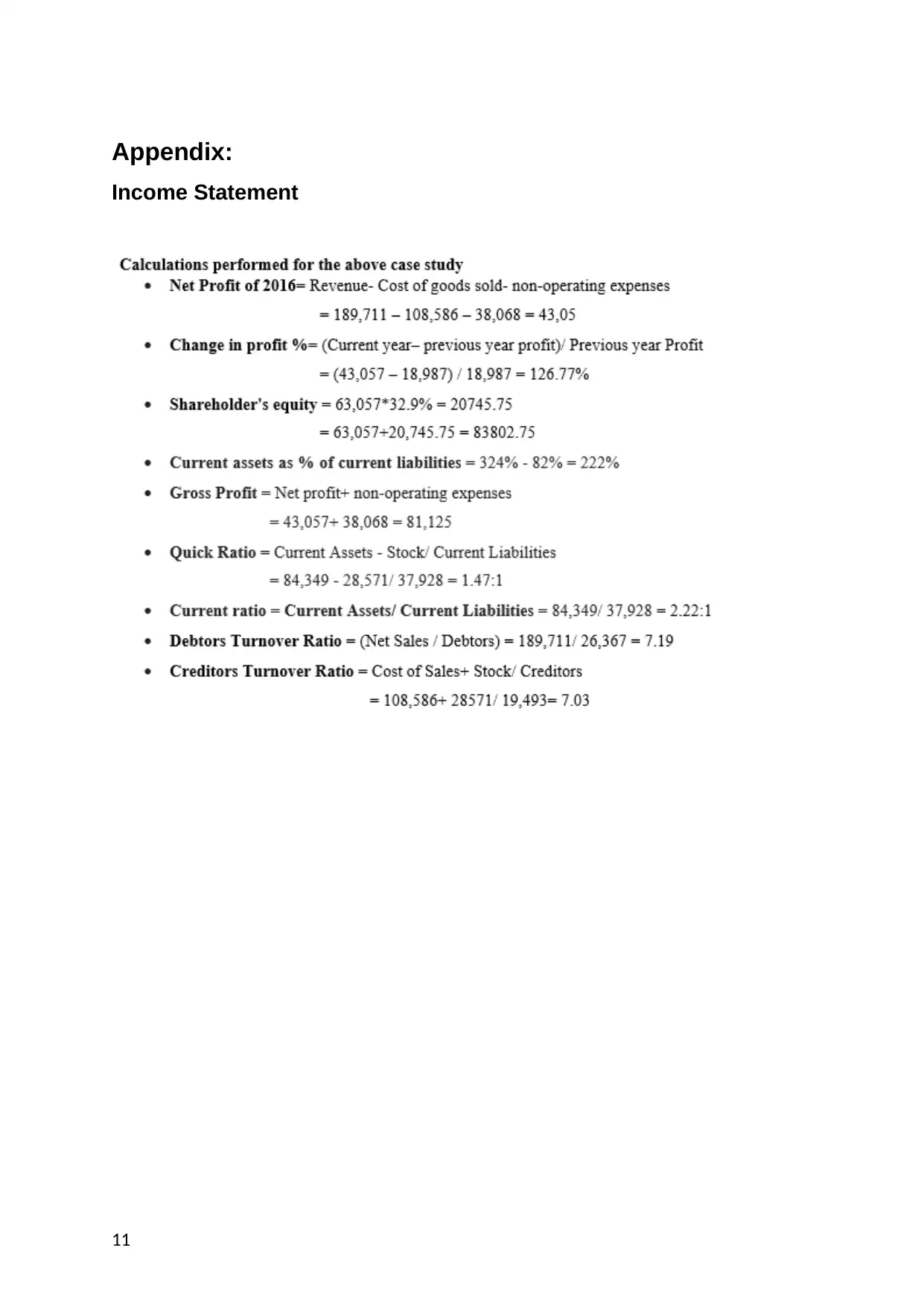
Appendix:
Income Statement
11
Income Statement
11
1 out of 11
Related Documents
Your All-in-One AI-Powered Toolkit for Academic Success.
+13062052269
info@desklib.com
Available 24*7 on WhatsApp / Email
![[object Object]](/_next/static/media/star-bottom.7253800d.svg)
Unlock your academic potential
Copyright © 2020–2025 A2Z Services. All Rights Reserved. Developed and managed by ZUCOL.


